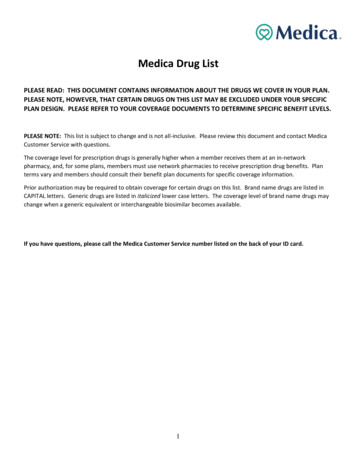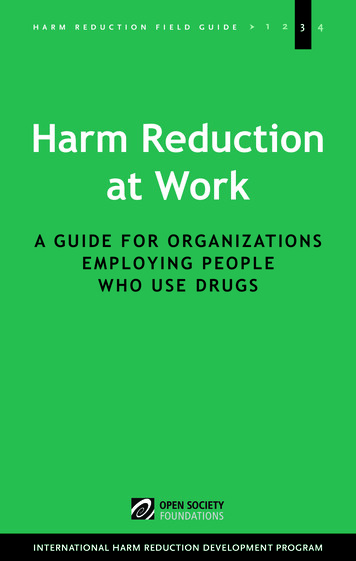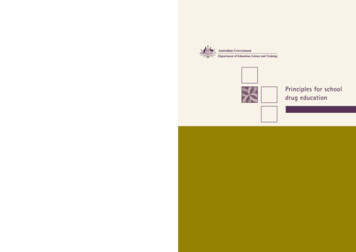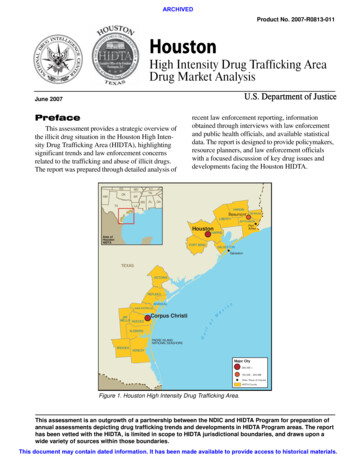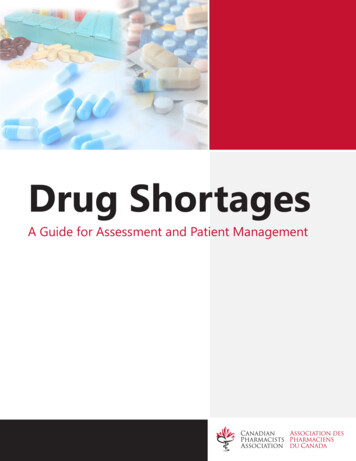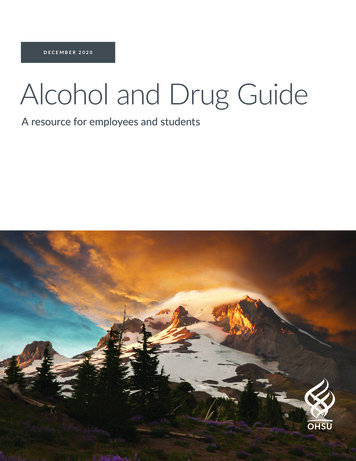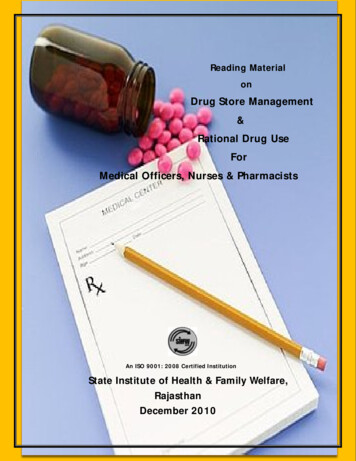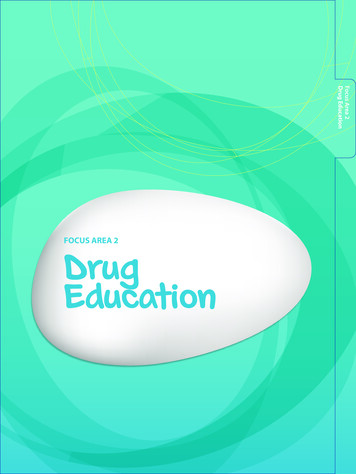
Transcription
Focus Area 2Drug EducationFOCUS AREA 2DrugEducation
INTRODUCTIONThis focus area provides the explicit teaching of contentand skills related to medicines, passive smoking andcaffeine for Year 4 students. It focuses on:yy introducing a definition of a drug and highlightinga range of legal drugs that are available in ourcommunityyy safe use of analgesics, prescription and over-thecounter medicines and non-medical alternatives tothese drugsyy health effects of passive smoking and ways to avoidpassive smokingyy health effects of caffeine and alternatives to food anddrinks containing caffeineyy identifying and responding to unsafe situationsaround analgesics, prescription and over-the-countermedicines, passive smoking and caffeine.Key skills to practiseyy Appreciate that others may have different opinionsand values about smoking.yy Share opinions about analgesics, prescription andover-the-counter medicines; smoking and caffeine use.yy Identify and respond to unsafe situations aroundsmoking and caffeine use.yy Make responsible decisions in smoking-relatedsituations.yy Monitor own caffeine intake.yy Speak assertively to others when dealing with healthand safety issues.yy Negotiate with peers to reach a decision.yy Participate in class, group and pair discussions aboutshared experiences.yy Share opinions in discussions and written responses.Key understandingsyy A drug is any substance (except food and water) which,when taken into the body, changes the way the bodyand mind function.yy Tobacco and alcohol are the drugs that cause the mostharm in our community.yy Drugs can have both helpful and harmful effects.yy Most young people choose not to smoke.yy There are a range of motivations for why young peoplechoose not to smoke.yy The younger a person starts smoking, the more likelythey are to become a lifelong, regular smoker.yy Different parts of the body are affected by tobacco.yy There is no safe use of tobacco.yy Passive smoke is more dangerous for children thanadults because their lungs are still developing.yy Children who are exposed to passive smoke can havebad chest infections.yy It is important to monitor caffeine use as too muchcaffeine can be harmful.yy Caffeine is found in a range of food and drinks such ascoffee, tea, cola, energy drinks and over-the-countermedicines.yy There are non-caffeine products that could besubstituted for those containing caffeine.yy Peers, family and the media can both positively andnegatively influence decisions to use analgesics andover-the-counter medicines, try smoking and useproducts containing caffeine. 2013 School Drug Education and Road AwareYEAR 4 FOCUS AREA 2: Drug Education 59
General capabilitiesin the Australian CurriculumThe general capabilities of the Australian Curriculumcomprise an integrated and interconnected set ofknowledge, skills, behaviours and dispositions that,together with curriculum content in each learning areaand the cross-curriculum priorities, will assist studentsto become successful learners, confident and creativeindividuals, and active and informed citizens.The content and activities in this focus area provideteachers with the opportunity to explicitly teach someof the general capabilities. The table outlines how thisresource addresses these capabilities.Addressing the Australian CurriculumGeneral Capabilities throughChallenges and ChoicesActivitypagetuning in1What is a drug andwhy do people use them?652Tobacco – the facts683Caffeine – the facts70finding out4Considering smoking risks735Most young peopledon’t smoke756Monitoring caffeineintake787Media and marketinginfluence attitudes to drugs81sorting out8Reasons why young peoplechoose not to smoke839Responding to marketinginfluences around drugs85reflecting10 What does this all mean to me?86KeyLiteracyNumeracyInformation and communication technology (ICT) capabilityCritical and creative thinkingEthical understandingPersonal and social capabilityIntercultural understanding60 YEAR 4 FOCUS AREA 2: Drug EducationChallenges and Choices: resilience, drug and road safety education
Teacher NotesAnalgesics, prescription andover-the-counter (OTC) drugsWhat are analgesics?‘Analgesics’ refers to depressant substances that are usedto relieve minor pain. Analgesics are often called painrelievers or painkillers. They slow down the activity of thebrain and include:yy aspirin (such as Disprin, AsproClear, Aspirin)yy paracetamol (such as Panadol, Dymadon, Tylenol)yy combination products that contain both aspirin andcodeine (such as Veganin) or paracetamol and codeine(such as Panadeine).Prevalence of analgesic useyy Analgesics are the most commonly used drugs among12-17 year old WA students with 95% having usedthem at some time in their lives, with females beingmore likely to use than males.1yy Australia has the greatest use of analgesics and renalfailure caused by analgesics in the Western world.Teaching young children about non-medicinalalternatives to analgesics challenges our drug takingculture.Death and diseaseyy Poisonings continue to be a cause of childhospitalisation in Western Australia. Education onthe safe use of medicines is therefore important forstudents and parents/caregivers alike.yy Aspirin use for children under the age of 12 years isdangerous. It can harm the stomach and intestinaltract and can cause Reye’s Syndrome (a rare butpotentially fatal condition). This information may notbe known by many parents and caregivers.yy Aspirin may cause irritation of the gastric mucousmembrane and even bleeding from the stomach.Excessive use may result in ringing in the ears,giddiness, nausea and mental aberration. Regular longterm use of aspirin may cause kidney damage andanaemia and asthma attacks.yy Paracetamol overdose can produce acute andsometimes fatal liver damage and also kidney damage.A dose of fewer than 10 tablets (25g) may be fatal.How analgesic and over-the-counter medicineeducation is taught is importantyy Sometimes analgesics will be the best form of shortterm treatment of pain however students should beencouraged to use analgesics after they have triedalternatives to pain relief.yy Stress that a good way to prevent pain is to maintaina balanced diet, be active every day, participate inhealthy relationships, and get sufficient rest.yy Students see analgesic use as harmless because theyare influenced by advertising and their parents’ andother adults’ example. Find opportunities to challengethese influences.yy Stress that a trusted adult is the only person who canadminister these drugs.yy Childhood poisonings are mainly caused by productscommonly found around the home includingmedicines (pain relievers and sleeping tablets),household cleaning agents (caustic cleaners for drains,dishwashing machine detergent), petrochemicals(kerosene, petrol) and pesticides andweedkillers.yy The majority of poisonings occurwhen the substance is not in itsusual place and has been recentlyused but not monitored by an adult.1 Australian School Student Alcohol and Drug (ASSAD) Survey –Illicit Drug Report 2011 – Western Australian results, Drug andAlcohol Office 2013 School Drug Education and Road AwareYEAR 4 FOCUS AREA 2: Drug Education 61
yy It is important to engage parents in these activitiesas it is unrealistic to expect young children to protectthemselves fully from the misuse of these drugs.yy Doctors recommend that children consume less than100mg of caffeine per day, which is approximately onecola drink and a 20g chocolate bar.Caffeineyy Caffeine is a stimulant drug which in its purest form,consists of bitter-tasting crystals. Caffeine is foundin many common substances such as coffee, tea,cocoa, chocolate, cola, energy drinks and bars, someprescription and over the counter medicines(eg No Doz) and other stimulants such as guarana.yy Caffeine poisoning can be seen with much smallerdoses in children, such as up to one gram of caffeine(about 12 energy drinks).yy Energy drinks should be avoided by children less than15 years old due to the high levels of caffeine in theseproducts.How caffeine education is taught is importantyy Students need to understand that being healthyinvolves maintaining a low caffeine intake. Low orno caffeine intake needs to be discussed as part ofbehaviours of healthy people.yy Many of the caffeine products that children consumealso contain high levels of sugar, so it would beappropriate to focus on this as part of a healthy diet.yy Focus on the peer and media influence to consumeenergy drinks if students identify that they areregularly using these products.yy Students should be able to identify productscontaining caffeine and also alternative foods anddrinks that can be consumed instead of those thatcontain caffeine.Effects on the bodyyy The effects of caffeine, like those of any drug, differfrom person to person depending on their age, bodysize and general health. Regular caffeine users mayhave different experiences from people who onlyconsume caffeine products occasionally.yy It is important to engage parents and carers in caffeineeducation as many children have little control overwhat they eat and drink, and many parents are notaware of the effects of caffeine.yy Caffeine is a stimulant drug so even a small amount(1-2 cups of average strength coffee) can stimulate thebrain and the central nervous system, making a personhave increased alertness, temperature, blood pressure,gastric acid secretion, and urination. These effectscontinue as long as caffeine remains in the blood,usually around 12 hours after consumption.What’s in tobacco?Tobacco contains thousands of chemicals that may harma person’s health, such as:yy tar, a black, sticky substance that contains manypoisonous chemical such as ammonia (found in floorand window cleaner), toluene (found in industrialsolvents) and acetone (found in paint stripper and nailpolish remover)yy nicotine, the addictive stimulant drug in tobaccofound in the tobacco plantyy carbon monoxide, a poisonous gas that reducesthe amount of oxygen taken up by a person’sred blood cellsyy hydrogen cyanide, the poison used in gas chambersduring World War llyy metals, including lead, nickel, arsenic (white antpoison) and cadmium (used in car batteries)yy pesticides such as DDT, methoprene (found in fleapowder) are used in growing tobacco.yy Disturbing physical effects of caffeine on some peopleinclude anxiety, irritability, increased breathing andheart rates, dizziness, headaches, dehydration andfrequent trips to the toilet.yy Caffeine is particularly harmful for young childrenbecause it can cause sleep problems, anxiety, irritabilityand bed wetting. There is also a danger that regular usemay threaten bone mass among young children sinceit causes excess secretion of calcium and magnesium.62 YEAR 4 FOCUS AREA 2: Drug EducationTobacco and passive smokingChallenges and Choices: resilience, drug and road safety education
Death and diseaseyy Tobacco smoking is the largest single preventablecause of death and disease in Australia today. Smokingis estimated to cause 15,500 deaths in Australia eachyear, which is over nine times the number of roadcrash fatalities.5yy Some of the diseases caused by smoking include: cancer (in the lung, lip, tongue, mouth, throat, nose,nasal sinus, voice box, oesophagus, pancreas, stomach,kidney, bladder, urethra, cervix, and bone marrow) heart disease stroke emphysema asthma blindness.Prevalence of tobacco smokingyy 95% of young people aged 12 to 17 describethemselves as non-smokers2 and about 81% of adultsdon’t smoke3. Many young people significantlyoverestimate this figure and often perceive smoking tobe a normal adult behaviour.yy The number of current smokers aged 12 to 17 yearshas decreased significantly over time falling from 17%in 1999, to 6% in 20112.yy Young people from lower socio-economic orAboriginal backgrounds often experience moreinfluences to start smoking, such as overt peerinfluence and a greater number of family memberswho smoke.4yy People who start smoking in their teen years are morelikely to become regular smokers, smoke more heavily,have difficulties quitting and are at greater risk ofgetting smoking-related diseases.Smoking remains one of the main factors influencingthe lower life expectancy of Aboriginal and Torres StraitIslander people. Smoking is responsible for one in five ofall Indigenous deaths and is the most preventable causeof poor health and early death among Aboriginal andTorres Strait Islander people.6Passive smokingyy Passive smoking is more harmful to young childrenthan adults as their respiratory systems are stilldeveloping.yy Children exposed to passive smoke are more likely tohave serious chest infections, poor lung function andgrowth, triggered asthma attacks and irritated eyes,throat and ears. Stress that some poisons in tobaccosmoke are more concentrated and dangerous in ‘sidestream’ smoke than ‘mainstream’ smoke because theparticles are unfiltered, smaller and reach deeper intothe lungs, and stay longer in the body.yy About 85% of the smoke in an average room wherepeople have been smoking is passive smoke. Thissmoke affects both smokers and non-smokers.yy More than a third (36%) of 12-17 WA students in 2011reported living with people who smoke.7yy The normative education activities in this moduleclarify misconceptions about tobacco use for students.It is important that students understand that youngpeople who don’t smoke are more likely to be one ofthe crowd rather than the odd person out.yy It is important to engage parents in tobacco educationas it is unrealistic to expect young children to protectthemselves fully from passive smoke.2 Australian School Students Alcohol and Drug Survey: TobaccoReport 2008, WA Results, Drug and Alcohol Office, 2011.3 National Drug Strategy Household Survey, 2010.4 Beggs, S., Vos, T., Baker, B., Stevenson, C., Stanley, L., and Lopez,A.D. (2007). The Burden of disease and injury in Australia 2003.Australian Institute of Health and Welfare – Canberra 2007(accessed 6 December 2012).5 National Tobacco Strategy 2004-2009, Ministerial Council onDrug Strategy, 2004.6 National Tobacco Strategy. 2012-2018 (Draft). Ministerial Councilon Drug Strategy, 2012.7 Australian School Student Alcohol and Drug (ASSAD) Survey:Tobacco Report 2011 – Western Australian results, Drug andAlcohol Office 2013 School Drug Education and Road AwareYEAR 4 FOCUS AREA 2: Drug Education 63
The addictive nature of nicotineyy Nicotine occurs naturally in the tobacco plant. Whentobacco smoke is inhaled, the vapour is absorbed veryquickly into the bloodstream through the lining of themouth and lungs.yy Nicotine is poisonous in large amounts however whensmoked, only a small dose is inhaled.yy The first symptoms of nicotine dependence can appearwithin days to weeks of the onset of occasional use,often before the onset of daily smoking. There doesnot appear to be a minimum nicotine dose or durationof use as a prerequisite for symptoms to appear.yy Interestingly, girls tend to develop symptoms ofnicotine addiction faster than boys.How tobacco prevention is taught is importantyy Research on the predictors of smoking suggests thatthe most promising school-based approaches: help children to develop negative attitudes tosmoking teach children how to cope socially while resistingpeer influences to smoke get parents to quit while their children are young have opportunities for students to participate inhealth-promoting activities prevent children from failing academically andbecoming alienated from school.8yy Encourage students to be ‘smoke free’ rather thanadvocating that students simply ‘don’t smoke’.yy Discussing smoking as a ‘deviant’ behaviour mayattract some students to take up smoking. Focus onpositive messages such as: most young people don’t smoke young people who do smoke generally respectthose who decide not to young people can become addicted to smokingeven if they don’t smoke many cigarettes, however,the fewer cigarettes a young person smokes, theeasier it is to stop.yy The available evidence-base suggests that effectivedrug education programs for students of this ageshould: increase student’s knowledge, social skills, andrefusal skills towards analgesics, prescription andover-the-counter medicines, tobacco and caffeine include scenarios relevant to students’ experiencesand interests contain highly interactive activities that engagestudents in problem-solving and critical thinking provide significant coverage of content aroundthese drugs supported by follow up boostersessions position drug education within a broader healthand wellbeing curriculum that focuses, amongstother things, on staying healthy and coping withstress respond to cultural and social needs of the schoolcommunity engage parents where possible.9Useful websitesyy School Drug Education and Road Awarewww.sdera.wa.edu.auyy Drug and Alcohol Officewww.dao.health.wa.gov.auyy Drug Awarewww.drugaware.com.auyy Reach Out Australiaau.reachout.comyy Oxygenwww.oxygen.org.auyy Kidshelpwww.kidshelp.com.auyy Alcohol Think Againwww.alcoholthinkagain.org.auyy Life Education Australiawww.lifeeducation.org.auyy School Drug Education Guidelines should treatsmoking as a health and safety issue rather thana disciplinary issue. (Refer to Getting it Together: AWhole-School Approach to Drug Education, SDERA, 2010for further information on developing School DrugEducation Guidelines including Procedures for IncidentManagement and Intervention Support.)8 Helen Cahill, Taking an evidence-based approach to classroom drugeducation. Australian Youth Research Centre, The University ofMelbourne, 20029 National Tobacco Strategy 2004-2009, Ministerial Council onDrug Strategy, 200464 YEAR 4 FOCUS AREA 2: Drug EducationChallenges and Choices: resilience, drug and road safety education
TUNING INActivity 1What is a drug and why dopeople use them?Preparation A3 sheet of paper – one per group Dot stickers – one per student Activity sheet Why do people use these drugs? –photocopy one per group A4 paper – one sheet per student Scissors – class set Empty tissue box or similar to be used asa ‘question box’yy Using the World Health Organisation definition,brainstorm (refer to page 188) a list of substances thatwould fit this definition. Prompt students to includecaffeine, analgesics and other prescription and overthe-counter medicines (such as cough suppressants,asthma medications, epi-pens, vaccines andantibiotics) as well as tobacco, alcohol and any illegaldrugs known by the class.AskWhat are some of the most commonly used drugsin Australia? (The most commonly used drugs arecaffeine, analgesics, alcohol and tobacco.)Which drugs cause the most harm? (The legal drugstobacco and alcohol are the two drugs that cause themost harm in our community. In fact, smoking is thelargest single cause of death and disease in Australia.The media sometimes may make us think that it isillegal drugs that cause the most harm.)Why is it important for some people to take medicinesregularly? (These medicines help them with a physicalor mental condition they may have eg diabetics,asthma sufferers, and people with ADHD).yy Place students with a partner or in a group of four.Give each group a sheet of paper. Explain how to use aplacemat (refer to page 194).Ask each student to write their own definition of a drugon the placemat. Remind students to consider all thedifferent types of drugs they know and ensure thattheir definition can be applied to all of these drugs.Explain that students should listen to the definitionscreated by other members of their group and theneither choose the best or combine their efforts to writea group definition in the centre of the placemat.Display the placemats and have the class use dotvoting (refer to page 201) to choose the definition thatthey think, best describes a drug.Explain the adapted World Health Organisationdefinition of a drug which is: A drug is any substance(except food and water) which, when taken into the body,changes the way the body and mind function. Comparethe most popular definition with the World HealthOrganisation definition.Tobaccoyy Give each group two cards from the Why do people usethese drugs? sheet. In their groups, students are to decide: reasons why some people may choose to use thisdrug the possible helpful and harmful effects of this drug alternatives to this drug or ways to reduce the riskof this drug.Draw the following table on the board. Have groupswrite their findings in the table. It may be usefulto group the caffeine products to help students’interpretation of the findings.Reasons why peopleuse this drugHelpful effectsHarmful effectsAlternatives or ways toreduce harmTo reduce stressThey are addictedTo lose weightMay relax people in theshort termMay help people not wantto eat so muchCauses lung, mouth, lip,Relaxation exercisesthroat and breast cancersTry to give upCauses heart diseaseGood food and exerciseCauses stained teeth andfingersEffects other people’shealth through passivesmoking, especially childrenCaffeine 2013 School Drug Education and Road AwareYEAR 4 FOCUS AREA 2: Drug Education 65
TUNING INDiscuss any similarities and differences in the findings.Correct any misinformation that students havegenerated.Stress that most people do not use drugs and thatall drugs have harmful effects. Stress the short termnature of some of the perceived ‘helpful’ effects(eg used to relax) and the more damaging and reallong term effects of the harms (eg cancers and heartdisease) and whether the ‘helpful’ effects are reallyworth these harms.AskWhat has this activity taught you about drugs? (Theycome in many forms. Some are used to help peoplelead healthy lives eg insulin. Drugs are everywherein our community. Drugs can have both helpful andharmful effects. People understand the word ‘drug’ tomean many different things.)yy Students write their answers to the following reflectivequestions on a sheet of paper. What’s one fact about drugs that you have learntfrom this activity? What’s one thing that you have learnt about drugsthat you can apply to your own life? What’s one question about drugs that is still goingaround in your head?Have students cut off the last question and ‘post’ it in aquestion box. Remind students that the questions areanonymous so they can feel free to ask anything theywant to know about drugs. The ‘question box’ is a goodstrategy to identify individual and class needs. Usethe questions to plan further activities or answer thequestions throughout this focus area.66 YEAR 4 FOCUS AREA 2: Drug EducationChallenges and Choices: resilience, drug and road safety education
NameActivity sheetWhy do people use these drugs?tobaccoalcoholcoffee (caffeine)energy drinks (caffeine)ventolin in an asthma pufferantibiotics for a throatinfectionsleeping pillspain reliever like Disprin (analgesics)insulin for diabetescold and flu tabletscola drink (caffeine)iron tablets 2013 School Drug Education and Road AwareYEAR 4 FOCUS AREA 2: Drug Education 67
TUNING INActivity 2Tobacco – the factsPreparation Activity sheet Tobacco facts – photocopy oneper student A cigarette and loose tobacco A3 paper – one sheet per groupyy Distribute a copy of Tobacco facts to each student.Read through the sheet together then discuss theinformation and clarify any questions.yy Show students the cigarette and loose tobacco. Manystudents may not have been exposed to either of theseforms of tobacco.AskWhy do you think this fact sheet was written?Did you find out something new about tobacco?Is tobacco a drug?What are some of the names you may have heard thisdrug being called? (eg ciggies, fags, lungers, butts,smokes)Why do you think most people choose not to use thisdrug? (eg health reasons, social reasons, financialreasons)Why do you think people use this drug? (eg curiosity,peer influence, stress relief, habit, boredom)What is your opinion about smoking?Do you think your opinion about smoking will changeas you get older? Why?In small groups, have students discuss the effects ofsmoking listed on the fact sheet. Ask the groups todecide which effect would most likely stop youngpeople their age from starting smoking, and markthis on their sheet. Listen to each group’s responseand why they selected the effect.Discuss the following as a whole class. There aremany video clips on the internet that can be viewedto support this discussion. How tobacco circulates through the body (ie alongthe respiratory tract, filtered through the lungsand then absorbed into the blood stream beforegoing to the brain). How nicotine rapidly reaches the brain andstimulates receptors that are sensitive tonicotine (these receptors are what cause physicaldependence). Immediate and short-term effects with emphasison lack of fitness, bad breath, smelly hair andclothes. How many of the short and long-term effects ofsmoking are also true of passive smoking. How tobacco affects the body with every puff notjust with long-term use.yy In groups, students complete a KWL (refer to page193) on ‘what they know’ and ‘want to know’ abouttobacco. The KWL should be drawn on an A3 sheetof paper. Review the students’ current knowledgeand questions as this will determine the selection ofsubsequent learning activities.Display the KWL findings around the room and invitestudents to complete the last column (‘what I havelearnt’) during this focus area.68 YEAR 4 FOCUS AREA 2: Drug EducationChallenges and Choices: resilience, drug and road safety education
NameActivity sheetTobacco factsAbout tobacco Three of the most harmful things in tobaccoare nicotine, tar and carbon monoxide. Nicotine is the main drug in tobacco.It is addictive, which means it is hard to gowithout. Tar is the thing that causes cancer and stainspeople’s teeth and fingers. Carbon monoxide is the gas that comes froma lit cigarette. It has no smell or colour andcan cause heart attacks.What’s the law?Effects of tobacco smoking Smoking affects your health and fitness andmakes clothes, hair and breath stink. It causes loss of smell and taste. It causes cancer of the lungs, mouth, throat,lips and breasts. It also causes lung disease and heart attacks. Passive smoking is breathing in someoneelse’s cigarette smoke. Children are more harmed by passivesmoke than adults. Passive smoke can trigger an asthma attack. It makes eyes and ears sore and can causeheart and lung disease. There are laws in Australia about who cansell tobacco and where it can be sold. It is illegal to sell tobacco productsto anyone under 18 years of age. There are laws about putting healthwarnings on cigarette packets. Smoking is not allowed inside or outsidemost restaurants, in work places and onpublic transport.Have a look at theSmarter than Smoking websitewww.oxygen.org.au for moreinformation about tobacco. 2013 School Drug Education and Road AwareYEAR 4 FOCUS AREA 2: Drug Education 69
TUNING INActivity 3Caffeine – the factsPreparation Activity sheet Facts about caffeine – photocopy onecard per student A collection of empty packets, boxes, wrappers,containers of a range of products with and withoutcaffeine (eg chocolate and lolly wrappers andpackets, choc milk and other flavoured milk cartons,cola and energy drink cans, other soft drink cans,tea and coffee) Three hoops labelled ‘has caffeine’, ‘no caffeine’and ‘unsure’yy Seat students in a circle and display the collection ofempty food and drink items, some with caffeine andsome without.Ask individual students to select one item and placeit into the appropriate labelled hoop then share thereasons for their choice. Continue this process until allitems have been classified. As a class, discuss the itemsthat have been placed in the ‘unsure’ hoop then movethem to the appropriate hoop.yy Conduct a question partners strategy (refer to page195). Distribute the question and answer cards fromFacts about caffeine. Make sure there is a matching cardfor each student. Explain that students are to find thecard that matches either their question or their answer.When all cards have been matched, listen to all ofthe questions and answers.AskWhat did you learn about caffeine?Why are we learning about caffeine? (So we can monitorour own caffeine intake and reduce it or continue toremain caffeine free to maintain our wellbeing.)Do you think companies who produce foods and drinkscontaining caffeine should put some of these facts ontheir packaging? Why? Why not?Why do many people continue to use caffeine eventhough it can have some nasty effects on the body? (Mostadults use under 600 mg of caffeine per day so theymay not be experiencing the harmful effects.)AskWere there any products that were in the ‘has caffeine’group that surprised you? If so, why?Were there any products that were in the ‘no caffeine’group that surprised you? If so, why?Put the number of fingers up to show how often youwould eat or drink something in the ‘has caffeine’ group.Seven fingers means every day of the week, one fingermeans once a week and a fist means never. (Note thestudents who identify high use of caffeine products.)Do you think it is healthy to eat or drink caffeine productsevery day? (Children under 15 years should notconsume products with high caffeine levels such asenergy drinks, as caffeine can affect a growing brain. Itis recommended that children stay well under 100mgof caffeine per day which is approximately one can ofcola and a small chocolate bar.)Ask students to bring in empty containers offoods and drinks containing caffeine. Use the listfrom the Caffeine and energy drinks informationsheet for families (refer to page 80) as examplesof the types of items required.70 YEAR 4 FOCUS AREA 2: Drug EducationChallenges and Choices: resilience, drug and road safety education
NameActivity sheetFacts about caffeineQuestionWhat is caffeine?AnswerCaffeine is the world’s most popular drug thatcomes from plants such as te
1 Australian School Student Alcohol and Drug (ASSAD) Survey - Illicit Drug Report 2011 - Western Australian results, Drug and Alcohol Office y Aspirin use for children under the age of 12 years is dangerous. It can harm the stomach and intestinal tract and can cause Reye's Syndrome (a rare but potentially fatal condition).


